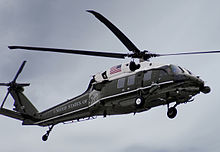Sikorsky S 70: Enhancing Helicopter Efficiency and Convenience
Sikorsky S 70: Enhancing Helicopter Efficiency and Convenience
Blog Article
Modernized Vertical Lift Platform With Advanced Composite Frameworks and Enhanced Security Actions
In the realm of vertical lift platforms, a substantial change in the direction of modernization has been observed, driven by the assimilation of sophisticated composite frameworks and increased precaution. These improvements stand for a pivotal evolution in the style and performance of lift platforms, guaranteeing raised efficiency and reliability across numerous markets (sikorsky s 70). As markets pursue better functional accuracy and safety standards, the utilization of composite materials and advanced safety and security attributes has actually come to be extremely important. In discovering the convergence of innovation and security in contemporary lift platforms, a compelling narrative arises, showcasing the capacity for transformative improvements that satisfy the ever-evolving requirements of industrial industries.
Evolution of Upright Lift Platforms

The evolution of vertical lift systems can be mapped back to basic wheel systems and early elevator styles. With time, technologies such as hydraulic systems, electric motors, and advanced control systems have actually significantly enhanced the efficiency and safety of these platforms. Makers have actually additionally concentrated on enhancing the stability, reach, and load-bearing capabilities of vertical lift systems to meet the diverse requirements of various markets.
In addition, the combination of clever technologies like sensors, IoT connectivity, and automation attributes has further changed the capacities of modern upright lift systems. These technological improvements not just boost functional efficiency but also make certain heightened safety standards for workers making use of these systems at numerous elevations. The constant development of vertical lift systems highlights their crucial duty in improving vertical mobility throughout markets.
Combination of Advanced Composite Frameworks

Additionally, the use of advanced composite products permits for even more complex and optimized architectural layouts, enabling engineers to tailor the system's homes to meet particular performance requirements. On the whole, the unification of sophisticated composite structures in modern upright lift systems represents a significant innovation in aerospace innovation, leading to much more efficient, dependable, and more secure airborne transportation systems.
Boosted Precaution Implementation
Applying improved safety procedures is critical in guaranteeing the optimum performance and reliability of contemporary upright lift systems. These measures incorporate a series of approaches aimed at mitigating dangers and improving total security standards. One go to this site vital element of enhanced safety and security measures is the combination of advanced sensing unit modern technologies to check different parameters in real-time. By making use of sensors for features such as structural health and wellness surveillance, load surveillance, and environmental picking up, prospective threats can be identified early, permitting positive upkeep and corrective actions.

Market Applications and Advantages
With improvements in technology and design, improved vertical lift systems have actually discovered varied applications throughout various industries, using significant advantages in effectiveness and productivity. The construction sector advantages from vertical lift systems by enabling employees to accessibility elevated areas securely and efficiently, enhancing total task timelines.
In addition, vertical lift platforms play a crucial role in the upkeep and repair work of facilities such as bridges, power lines, and buildings, allowing professionals to reach unattainable locations with ease (sikorsky s 70). The aeronautics industry also leverages these systems for aircraft upkeep and assembly tasks, enhancing process effectiveness and making certain worker security at elevations. Generally, the widespread adoption of up-to-date vertical lift systems throughout industries highlights their adaptability and the substantial improvements they bring to various procedures
Future Trends in Lift Platform Technology
Including sophisticated automation and intelligent functions, lift system technology is poised to revolutionize upright transport systems in the close to future. One key pattern is the combination of Web of Points (IoT) innovation, enabling lift systems to connect real-time information for predictive maintenance, maximizing performance, and enhancing safety and security. As lift system technology continues to evolve, these fads are established to shape the future of vertical address transport, making it extra reliable, risk-free, and straightforward.
Final Thought
In final thought, the up-to-date upright lift platform showcases the development of technology in the industry. By integrating sophisticated composite structures and boosted safety and security steps, this system offers increased efficiency and safety and security for numerous applications. The industry can profit substantially from these innovations, and future fads in lift system innovation are most likely to continue surpassing these technologies for even greater success and efficiency.
In the world of upright lift systems, a significant change in the direction of innovation has actually been observed, driven by the combination of advanced composite frameworks and heightened safety and security steps. The continuous development of vertical lift systems underscores their essential role in improving vertical flexibility throughout markets.

The incorporation of advanced composite frameworks in modern-day upright lift platforms has significantly boosted their architectural stability and performance abilities. By incorporating these innovative composites right into the design and building and construction of upright lift systems, producers can minimize total weight, boost load-carrying capacity, and enhance the platform's sturdiness and long life.
Implementing boosted safety measures is necessary in making certain the optimal performance and reliability of modern-day upright lift systems.
Report this page